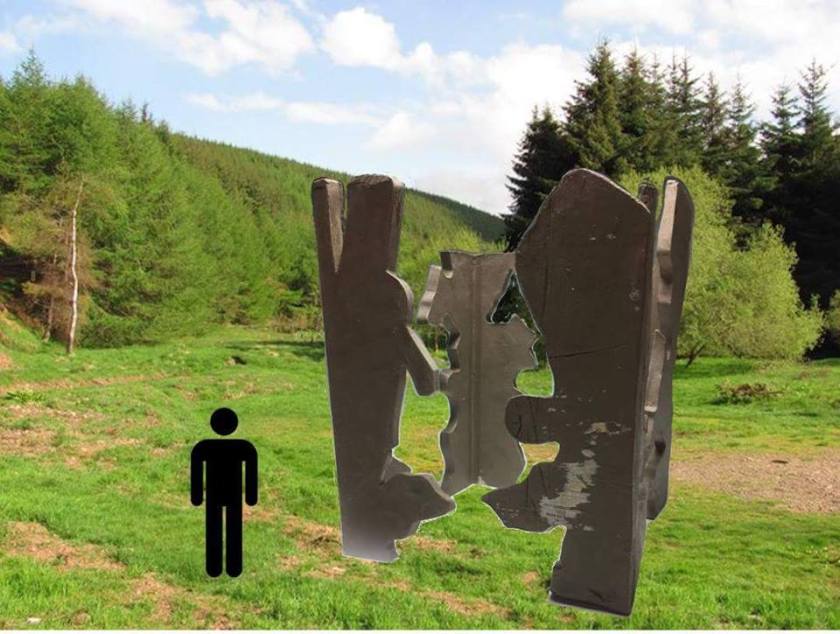Rwyf wedi ymuno â’r elfen Gymraeg o’r cwrs ac ar hyn o bryd yn gweithio ar wahanol brosiectau e.e.. creu, allan o wifren, adeilad sy’n bodoli yng Nghaerdydd, a fydd wedyn yn cael ei gyflwyno ar gyfer cystadleuaeth ac yn cyfrannu at maes.
Hyd yn hyn, rwyf wedi dechrau ar y gwersi a fydd yn ehangu fy nealltwriaeth o sut i gael gwifrau i doddi gan ddefnyddio gwres a ddaw o drydan ac wedi creu darnau fel sydd yn llun isod (sydd ddim yr esiampl gorau, ond roedd yn ymarfer wych!).
Rwyf wedi dechrau gweithio ar fy adeilad gwifren, sef John Lewis, gan fy mod yn meddwl fod yr adeilad yn un diddorol iawn i edrych arno ac wedi ei adeiladu gan ddefnyddio dull haniaethol i edrych bron fel blaen llong. Dyma’r math o luniau y byddaf yn ceisio seilio fy ngwaith arnynt.
Dyma yw fy nghynnydd hyd yn hyn;
Er credaf fod y canlyniad terfynol yn eithaf llwyddiannus, nid wyf yn hollol hapus gyda’r ffordd y gwnaeth y darn o waith droi allan. Roedd yn anodd i blygu’r wifren oherwydd ei fod yn drwchus, ac arweiniodd hyn at ychydig o nodweddion i edrych yn rhyfedd. Roedd hefyd yn anodd i wneud ‘spotweld’ os nad oedd y wiren mewn man penodol. Canlyniad hyn oedd bod ‘spotwelding’ yr adeilad yn arbennig o anodd. Fodd bynnag, mae’r darn yn debyg i fy nghynllun gwreiddiol ac yn sefyll i fyny sydd, ar y cyfan, yn fy ngwneud yn falch o’r canlyniad terfynol.
Ar gyfer fy ail brosiect byr, rydym fel grwp ac yn unigol yn creu cyfres o oleuadau crog. gwneir rhain o boteli gwydr sydd wedi ei thorri yn hanner ac yn cynnwys gwead ar eu harwyneb sydd wedi ei seilio ar gynllun. Prif amcanion y gwaith yma yw datblygu sgiliau cyd-weithio a datrys problemau. Erbyn hyn, rydwi i wedi creu pum fraslyn sydd wedi eu hysbrydoli gan thema ‘Dyfodol Nawr’. Bydda i a fy ngrwp i’n cydweithio i werthuso’r syniad a phenderfynu ar ba tri ddyla ni fireinio’n bellach ar gyfer cynhyrchu. Fy syniadau i yw edrych ar rhagfyniediadau pobl o sut bydd ein dyfodol ni’n edrych mewn 50+ blwyddyn, felly edrychais ar tyrbin gwynt, pobl yn byw yn hyn, adeiladau eithriadol o dal, adeiladau efo gerddi a phlanhigion ar eu toeau ac anifeiliaid gwyllt yr ydym efo nawr mewn amgueddfeydd oherwydd eu bod nhw’n ddiflanedig.
Mae’r themau wedi newid i fudiad celf a phensaernïol sef Lluniadaeth a ddechreuodd yn Rwsia yn 1919. Prif y nod Lluniadaeth oedd ffafrio’r defnydd o Gelf tuag at bwrpasau cymdeithasol â wnaeth barhau tan 1934.
Dyma enghreifftiau dwi am ddefnyddio i ysbrydoli fy nghynlluniau;
A dyma yw’r dyluniadau rydw i wedi gwneud erbyn hyn;
Cychwynnais wneud deg braslun drwy edrych ar y lluniau y gwelais mewn llyfr. Dwi’n ceisio edrych yn fanwl ar y siapiau geometrig, fel trionglau a sgwariau, a llinellau hir efo bylchau er mwyn creu dyfnder/edrychiad 3D yn y lluniau. Dwi hefyd yn trio cadw’r brasluniau mor syml ac sy’n bosibl oherwydd mae’n creu edrychiad modern iawn i’r adeiladau. Byddaf hefyd yn defnyddio sgwariau a thrionglau i greu edrychiad llonydd a cadarn iawn i’r adeiladau gan fod y lluniau o’r llyfr yn dangos llawer iawn o adeiladau o gyflwr solet iawn.
Dwi wedi gwneud pum braslun sydd yn fwy gorffenedig erbyn hyn. Dwi’n teimlo eu bod nhw i gyd yn ddigon syml a modern i alluogi i mi eu torri allan er mwyn eu defnyddio ar fy mhoteli ond efallai dydi’r rhai crwn a’r rhai triongl ddim am ffitio yn dda iawn ar y poteli, felly ni fyddai’n gallu defnyddio’r cynlluniau yna (sydd isod).
Dewisais y tri dyluniad yma i wneud ar fy nhair potel gan eu bod nhw’n ddigon hawdd torri allan a hefyd nhw sydd yn mynd efo’r themâu orau
Efo’r dyluniau yma, torrais allan y siapiau ar ddarn o vinyl er mwyn gallu rhoi ar y boteli er mwyn gallu rhoi nhw i fewn ‘sandblast’;
Treuliodd ni bore, fel grwp, hel syniadau tuag at ein prosiect newydd. Mae ein syniadau i gyd o amgylch y brifysgol a sut ydym yn teimlo yma. Yn bersonol, fe wnes i ddangos sut oni’n teimlo her ac yn poeni dros pethau fel pres yn aml, a dyma be wnaethom ni ddod allan efo;
Dyma’r boteli gorffenedig;
Dwi’n eithaf hapus gyda sut wnaeth y poteli droi allan, er fod y sandblast heb weithio yn grêt i mi. Mae’r golau tu mewn i’r poteli yn dangos y siapiau yn dda ac yn creu edrychiad diddorol iawn i’r poteli drwy creu symudiad a chysgodion llawn siapiau gwahanol o’r thema celf phensaernîol . Mae symud y golau o amgylch y poteli hefyd yn creu edrychiad gwahanol, sydd yn diddorol iawn edrych ar, gan drio dal beth sy’n digwydd efo camera, gan fod y siapiau o’r sandblast yn symud gyda’r cysgodion. Ar y llaw arall, byddai’n sicr o wneud yn siwr fod y sandblast yn gweithio yn iawn cyn ei ddefnyddio tro nesa, gan fod dyna sydd yn gadael y darn i lawr, yn fy marn i. Ond mi wnesi mwynhau y prosiect yn fawr iawn ac yn sicr o ddefnyddio y prosesau eto yn y dyfodol.



































































































































































































